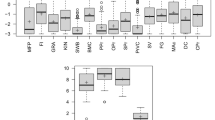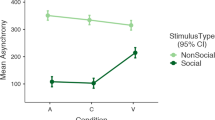Abstract
This study examined the effect of sensory feedback (e.g., flashing lights and sound) on the imitation performance of children with autism and typical children group-matched for mental age. Participants were administered an immediate object-imitation task with six novel toys constructed for this study: three with a sensory effect that could be activated by imitating the modeled action and three without a sensory effect. Although overall imitation performance did not differ significantly between the two groups, the imitation performance of the participants with autism was significantly higher with sensory toys than with nonsensory toys. Typical participants' imitation performance did not differ between the two sets of toys. Both groups played significantly more with the sensory toys during free play, indicating that sensory toys were more reinforcing for both groups. Additional results demonstrated that typical children used significantly more social behaviors during imitation than children with autism, but they did not differ in objectoriented behaviors, replicating previous findings. It is argued that children with autism may be less motivated to imitate by social interaction, but may be motivated to imitate to receive a nonsocial reward (sensory feedback).
Similar content being viewed by others
References
Abravanel, Levan-Goldschmidt, & Stevenson (1976). Action imitation: the early phase of infancy. Child Development, 47, 1032-1044.
Baron-Cohen, S. (1988). Social and pragmatic deficits in autism: Cognitive or affective? Journal of Autism and Developmental Disorders, 18, 379-402.
Bayley, N. (1993). Bayley Scales of Infant Development (2nd ed.). San Antonio, TX: Harcourt Brace & Company.
Charman, T., & Baron-Cohen, S. (1994). Another look at imitation in autism. Development and Psychopathology, 6, 403-413.
Charman, T., Swettenham, J., Baron-Cohen, S., Cox, A., Baird, G., & Drew, A. (1997). Infants with autism: An investigation of empathy, pretend play, joint attention, and imitation. Developmental Psychology, 33, 781-789.
Curcio, F. (1978). Sensorimotor functioning and communication in mute autistic children. Journal of Autism and Childhood Schizophrenia, 8, 281-292.
Dawson, G., Hill, D., Spencer, A., Galpert, L., & Watson, L. (1990). Affective exchanges between young autistic children and their mothers. Journal of Abnormal Child Psychology, 18, 335-345.
DeMyer, M., Alpern, G., Barton, S., DeMyer, W., Churchill, D., Hingtgen, J., Bryson, C., Pontius, W., & Kimberlin, C. (1972). Imitation in autistic, early schizophrenic, and non-psychotic subnormal children. Journal of Autism and Childhood Schizophrenia, 2, 264-287.
Eckerman, C., & Didow, S. (1996). Nonverbal imitation and toddlers' mastery of verbal means of achieving coordinated action. Developmental Psychology, 32, 141-152.
Eckerman, C. O., & Stein, M. (1990). How imitation begets imitation and toddlers' generation of games. Developmental Psychology, 26, 370-378.
Gilliam, J. E. (1995). Gilliam Autism Rating Scale. Austin, TX: Pro-Ed.
Hammes, J., & Langdell, T. (1981). Precursors of symbol formation and childhood autism. Journal of Autism and Developmental Disorders, 11, 331-46.
Hobson, R. P., & Lee, A. (1999). Imitation and identification in autism. Journal of Child Psychology and Psychiatry, 40, 649-659.
Jones, V., & Prior, M. (1985). Motor imitation abilities and neurological signs in autistic children. Journal of Autism and Developmental Disorders, 15, 37-46.
Kasari, C., Sigman, M., Mundy, P., & Yirmiya, N. (1990). Affective sharing in the context of joint attention interactions of normal, autistic, and retarded children. Journal of Autism and Developmental Disorders, 20, 87-100.
Kugiumutzakis, G. (1999). Genesis and development of early infant mimesis to facial and vocal models. In J. Nadel & G. Butterworth (Eds.), Imitation in infancy (pp. 36-60). Cambridge: Cambridge University Press.
Libby, S., Powell, S., Messer, D., & Jordan, R. (1997). Imitation of pretend play acts by children with autism and Down's Syndrome. Journal of Autism and Developmental Disorders, 27, 365-383.
Maurice, C., Green, G., & Luce, S. (Eds.) (1996). Behavioral intervention for young children with autism: A manual for parents and professionals. Austin, TX: Pro-Ed.
Meltzoff, A. N. (1988). Infant imitation and memory: Nine-montholds in immediate and deferred tests. Child Development, 59, 217-225.
Morgan, S., Cutler, P., Coplin, J., & Rodrique, J. (1989). Do autistic children differ from retarded and normal children in Piagetian sensorimotor functioning? Journal of Child Psychology and Psychiatry, 30, 857-864.
Mundy, P. (1995). Joint attention and social-emotional approach behavior in children with autism. Development and Psychopathology, 7, 63-82.
Nadel, J., Guerini, C., Peze, A., & Rivet, C. (1999). The evolving nature of imitation as a format for communication. In J. Nadel & G. Butterworth (Eds.), Imitation in infancy (pp. 209-233). Cambridge: Cambridge University Press.
Ohta, M. (1987). Cognitive disorders of infantile autism: A study employing the WISC, spatial relationship conceptualization, and gesture imitations. Journal of Autism and Developmental Disorders, 17, 45-63.
Pierce, K., Glad, K., & Schreibman, L. (1997). Social perception in children with autism: An attentional deficit? Journal of Autism and Developmental Disorders, 27, 265-282.
Pierce, K., & Schreibman, L. (1995). Increasing complex social behaviors in children with autism: Effects of peer-implemented pivotal response training. Journal of Applied Behavior Analysis, 28, 285-295.
Roeyers, H., Van Oost, P., & Bothuyne, S. (1998). Immediate imitation and joint attention in young children with autism. Development and Psychopathology, 10, 441-450.
Rogers, S., & Bennetto, L. (2000). Intersubjectivity in autism: The roles of imitation and executive function. In A. Wetherby & B. Prizant (Eds.), Autism spectrum disorders: A transactional developmental perspective (pp. 79-107). Baltimore, MD: Paul H. Brookes.
Rogers, S., Bennetto, L., McEvoy, R., & Pennington, B. (1996). Imitation and pantomime in high-functioning adolescents with autism spectrum disorders. Child Development, 67, 2060-2073.
Rogers, S., & Pennington, B. (1991). A theoretical approach to the deficits in infantile autism. Developmental Psychology, 3, 137-162.
Sigman, M., & Ruskin, E. (1999). Continuity and change in the social competence of children with autism, Down Syndrome, and developmental delays. Monographs of the Society for Research in Child Development, 64, 1-114.
Sigman, M., & Ungerer, J. (1984). Cognitive and language skills in autistic, mentally retarded and normal children. Developmental Psychology, 20, 293-302.
Smith, I., & Bryson, S. (1994). Imitation and action in autism: A critical review. Psychological Bulletin, 116, 259-273.
Smith, I., & Bryson, S. (1998). Gesture imitation in autism I: Nonsymbolic postures and sequences. Cognitive Neuropsychology, 15, 747-770.
Stone, W., Ousley, O., & Littleford, C. (1997). Motor imitation in young children with autism: What's the object? Journal of Abnormal Child Psychology, 25, 475-485.
Trevarthen, C., Kokkinaki, T., & Fiamenghi, G. (1999). What infants' imitations communicate: With mothers, with fathers and with peers. In J. Nadel & G. Butterworth (Eds.), Imitation in infancy (pp. 127-185). Cambridge: Cambridge University Press.
Uzgiris, I. (1981). Two functions of imitation in infancy. International Journal of Behavioral Development, 4, 1-12.
Uzgiris, I. (1990). The social context of infant imitation. In M. Lewis & S. Feinman (Eds.), Social influences and socialization in infancy (pp. 215-51). New York: Plenum Press.
Whiten, A., & Brown, J. (1998). Imitation and the reading of other minds: Perspectives from the study of autism, normal children, and non-human primates. In S. Braten (Ed.), Intersubjective communication and emotion in early ontogeny (pp. 260-280). New York: Cambridge University Press.
Author information
Authors and Affiliations
Corresponding author
Rights and permissions
About this article
Cite this article
Ingersoll, B., Schreibman, L. & Tran, Q.H. Effect of Sensory Feedback on Immediate Object Imitation in Children with Autism. J Autism Dev Disord 33, 673–683 (2003). https://doi.org/10.1023/B:JADD.0000006003.26667.f8
Issue Date:
DOI: https://doi.org/10.1023/B:JADD.0000006003.26667.f8




